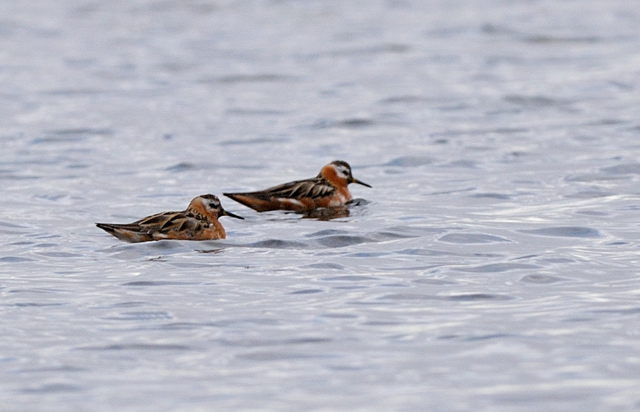279. Pectoral Sandpiper Calidris melanotos (Geelpootstrandloper)
Order: Charadriiformes. Family: Scolopacidae
Description
19-23 cm. Brown scaled upperparts (greyer in non-breeding season) with dark cap to the head. Breast markings streaked with sharp demarcation to the white underparts. It has slightly downcurved bill, and yellow-brown legs. Best told by well-streaked buffy breastband terminating in a sharp line and contrasting with pure white underparts plus a dark crown.
The juveniles are more brightly patterned above with rufous colouration and white mantle stripes.
It is longer-necked than the stints, with a dark-capped appearance and darker upperparts.
Distribution
Breeds at high latitudes in coastal tundra from Taimyr Peninsula, Siberia to the western coast of Hudson Bay, Canada. In the non-breeding season it heads south to South America between 20-40° South, with smaller numbers in east Asia, Australia and New Zealand. It is a rare vagrant to southern Africa, with over the three dozen records spread out across the region (excluding Mozambique), all sighted in the period from September-May. It is most commonly recorded along the west coast of the Western Cape.
Habitat
Estuaries and wetlands with muddy margins, sewage works and small farm dams.
Diet
Arthropods & invertibrates.
Breeding
The Pectoral Sandpiper builds a steep-sided scrape nest with a considerable volume of lining material. The nest is deep enough that the eggs sit about 3 cm below ground level, which helps to minimize heat loss from the cool breezes which occur at the latitudes where the species nests. The female lays four eggs.
Call
Harsh, trilled drrup or jrrff. Listen to Bird Call.
Status
Rare vagrant to the sub-region, summer visitor.
Africa Wild Bird Book
Pectoral Sandpiper
Dewi
What is the good of having a nice house without a decent planet to put it on? (H D Thoreau)
What is the good of having a nice house without a decent planet to put it on? (H D Thoreau)
Pectoral Sandpiper Photos
279. Pectoral Sandpiper Calidris melanotos

Links:
Sabap2
Hockey, P.A.R. 1998. Africa’s waders: a guide to their identification. Part 1. Africa - Birds & Birding 3(1):53-61.

Links:
Sabap2
Hockey, P.A.R. 1998. Africa’s waders: a guide to their identification. Part 1. Africa - Birds & Birding 3(1):53-61.
Dewi
What is the good of having a nice house without a decent planet to put it on? (H D Thoreau)
What is the good of having a nice house without a decent planet to put it on? (H D Thoreau)
- nan
- Posts: 26488
- Joined: Thu May 31, 2012 9:41 pm
- Country: Switzerland
- Location: Central Europe
- Contact:
Curlew Sandpiper
272. Curlew Sandpiper Calidris ferruginea (Krombekstrandloper)
Order: Charadriiformes. Family: Scolopacidae
Description
Size 18-23 cm. The only small, plain, greyish wader with an obviously decurved black bill. The legs and feet are black. In flight it has a squarish white rump, variably scalloped with pale grey.
Non-breeding adult has distinct white supercilium and is grey-brown above and white below.
In breeding plumage becomes blotched and the underparts and face rufous.
Male is brighter than female. Juvenile has buffy edgings to the mantle feathers, a grey and brown back, a white belly and a peach-coloured breast.
Distribution
Breeds in coastal of Arctic tundra above 70° North, from the Jamal Peninsula, western Siberia to the Bering Strait and north-western Alaska. In the non-breeding season it heads below 20° North, from the Indian Ocean islands to New Zealand and sub-Saharan Africa, from Mauritania to Somalia south to southern Africa.
Habitat
Coastal and freshwater wetlands, usually in flocks.
Diet
It mainly eats invertebrates, doing most of its foraging on mudflats, pecking and probing the soft mud in search of food; generally single birds are less successful than foraging flocks. Females are faster and more effective foragers than males but they feed on a smaller diversity of prey.
Movements and migrations
All southern African birds breed in west-central Siberia, with adults arriving in southern Africa from August-November and leaving again in March and April. Juveniles typically arrive about 4 weeks later than the adults and usually stay in the region over winter before joining the next group of migrants back to the breeding grounds. The proportion of juveniles varies greatly according to the population of lemmings (Dicrostonyx torquatus and Lemmus sibiricus) at its Siberian breeding colonies. This is caused by the fact that lemmings are the main prey of Arctic foxes (Alopex lagopus) and are generally scarce every third year, which causes the foxes to switch to preying on ground-nesting bird's eggs and chicks. In years when lemmings are abundant, juveniles form approximately 12-65% of all Curlew sandpipers in southern Africa but in years when lemmings are scarce this figure drops to just 0.2-11%.
Call
A short trill chirrup. Listen to Bird Call.
Status
Very common summer visitor, regularly overwinters. Classified as Least Concern (LC) on the IUCN Red List.
Order: Charadriiformes. Family: Scolopacidae
Description
Size 18-23 cm. The only small, plain, greyish wader with an obviously decurved black bill. The legs and feet are black. In flight it has a squarish white rump, variably scalloped with pale grey.
Non-breeding adult has distinct white supercilium and is grey-brown above and white below.
In breeding plumage becomes blotched and the underparts and face rufous.
Male is brighter than female. Juvenile has buffy edgings to the mantle feathers, a grey and brown back, a white belly and a peach-coloured breast.
Distribution
Breeds in coastal of Arctic tundra above 70° North, from the Jamal Peninsula, western Siberia to the Bering Strait and north-western Alaska. In the non-breeding season it heads below 20° North, from the Indian Ocean islands to New Zealand and sub-Saharan Africa, from Mauritania to Somalia south to southern Africa.
Habitat
Coastal and freshwater wetlands, usually in flocks.
Diet
It mainly eats invertebrates, doing most of its foraging on mudflats, pecking and probing the soft mud in search of food; generally single birds are less successful than foraging flocks. Females are faster and more effective foragers than males but they feed on a smaller diversity of prey.
Movements and migrations
All southern African birds breed in west-central Siberia, with adults arriving in southern Africa from August-November and leaving again in March and April. Juveniles typically arrive about 4 weeks later than the adults and usually stay in the region over winter before joining the next group of migrants back to the breeding grounds. The proportion of juveniles varies greatly according to the population of lemmings (Dicrostonyx torquatus and Lemmus sibiricus) at its Siberian breeding colonies. This is caused by the fact that lemmings are the main prey of Arctic foxes (Alopex lagopus) and are generally scarce every third year, which causes the foxes to switch to preying on ground-nesting bird's eggs and chicks. In years when lemmings are abundant, juveniles form approximately 12-65% of all Curlew sandpipers in southern Africa but in years when lemmings are scarce this figure drops to just 0.2-11%.
Call
A short trill chirrup. Listen to Bird Call.
Status
Very common summer visitor, regularly overwinters. Classified as Least Concern (LC) on the IUCN Red List.
Kgalagadi lover… for ever
https://safrounet.piwigo.com/
https://safrounet.piwigo.com/
- nan
- Posts: 26488
- Joined: Thu May 31, 2012 9:41 pm
- Country: Switzerland
- Location: Central Europe
- Contact:
Curlew Sandpiper Photos
272. Curlew Sandpiper Calidris ferruginea

Female, Macaneta Wetlands, about 30 kms north of Maputo © Dindingwe

Male in transition plumage, Macaneta Wetlands, about 30 kms north of Maputo © Dindingwe
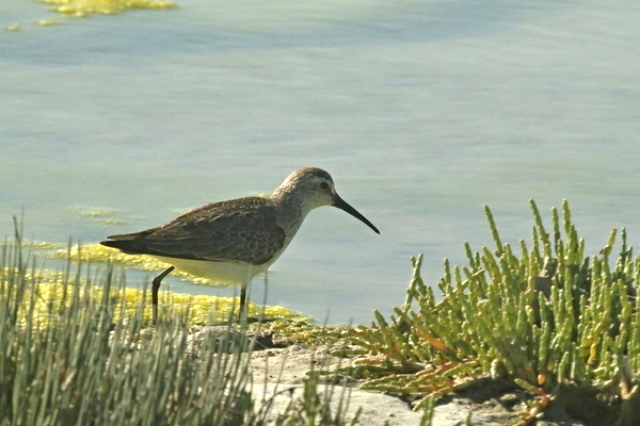
West Coast National Park, Western Cape

Non-breeding
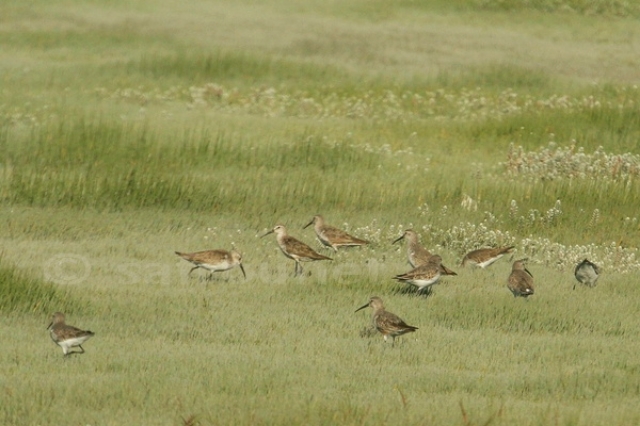
West Coast National Park, Western Cape
Links:
Species text in The Atlas of Southern African Birds
Sabap2:
Migration and moult strategy of the Curlew Sandpiper
[url=http://www.fitzpatrick.uct.ac.za/sites/ ... 953-61.pdf[/url]
Female, Macaneta Wetlands, about 30 kms north of Maputo © Dindingwe
Male in transition plumage, Macaneta Wetlands, about 30 kms north of Maputo © Dindingwe

West Coast National Park, Western Cape

Non-breeding

West Coast National Park, Western Cape
Links:
Species text in The Atlas of Southern African Birds
Sabap2:
Migration and moult strategy of the Curlew Sandpiper
[url=http://www.fitzpatrick.uct.ac.za/sites/ ... 953-61.pdf[/url]
Kgalagadi lover… for ever
https://safrounet.piwigo.com/
https://safrounet.piwigo.com/
- nan
- Posts: 26488
- Joined: Thu May 31, 2012 9:41 pm
- Country: Switzerland
- Location: Central Europe
- Contact:
Dunlin
273. Dunlin Calidris alpina (Bontstrandloper)
Order: Charadriiformes. Family: Scolopacidae
Description
Size 15-22 cm. Medium-sized sandpiper. The black bill is long and slightly decurved. Legs and feet are black.
This species is also renowned for its beautiful breeding plumage, which is distinguished by the reddish cap, bright reddish-brown back and black belly patch, which extends behind its black legs. The head and breast are pale brown.
Outside of the breeding season, the dunlin is light brownish-grey with a brownish back, white underparts and a brownish band streaking across the upper breast.
Juvenile is similar to non-breeding adult. Brown above with two whitish "V" shapes on the back. They usually have black marks on the flanks or belly and show a strong white wingbar in flight.
Similar species: The Dunlin's bill is less evenly curved than that of Curlew Sandpiper, from which it differs by its less conspicuous eyebrow stripe and the dark rump with white edges. Curlew Sandpipers usually show an obvious white stripe above the eye, extending from the bill to well behind the eye. This feature is absent in Dunlin. Broad-billed Sandpiper has paler, shoter legs, a striped head and a flattened bill tip.
Distribution
The Dunlin has a very wide distribution, occurring across nearly all Arctic regions. Breeds in the circumpolar region above 55° North, dispersing in the non-breeding season to coasts further south up to the area north of the equator, such as between Guinea and Sudan in Africa. It is a rare vagrant further south, including to southern Africa, where it has been sighted five times: twice at the Western Cape coast, once at central Namibia's coast and twice inland in north-eastern South Africa.
A migratory species, the dunlin has a number of sub-populations that each has differing migration behaviours.
Habitat
Coastal wetlands.
Diet
The Dunlin moves along the coastal mudflat beaches it prefers with a characteristic 'sewing machine' feeding action, methodically picking small food items. Insects form the main part of the Dunlin's diet on the nesting grounds; it eats mollusks, worms and crustaceans in coastal areas.
Breeding
The male Dunlin arrives at the breeding grounds first, and pairs are established upon the females’ arrival. The males attract a partner by performing display flights, which consist of short glides with stiff arched wings, interrupted by rapid, shallow flutters. The male makes a few scrapes on the ground, which are then lined with grass, sedges and leaves. The female chooses one of the scrapes as the nest and finishes its construction. The nest is often concealed in vegetation and sometimes in a tuft or tussock. Usually 4 eggs are laid, which are then incubated for 20 to 22 days. The young leave the nest shortly after hatching, but are tended by the adults until they are ready to fledge, usually at about 19 days.
Call
A weak treep. Listen to Bird Call.
Status
Vagrant.
Order: Charadriiformes. Family: Scolopacidae
Description
Size 15-22 cm. Medium-sized sandpiper. The black bill is long and slightly decurved. Legs and feet are black.
This species is also renowned for its beautiful breeding plumage, which is distinguished by the reddish cap, bright reddish-brown back and black belly patch, which extends behind its black legs. The head and breast are pale brown.
Outside of the breeding season, the dunlin is light brownish-grey with a brownish back, white underparts and a brownish band streaking across the upper breast.
Juvenile is similar to non-breeding adult. Brown above with two whitish "V" shapes on the back. They usually have black marks on the flanks or belly and show a strong white wingbar in flight.
Similar species: The Dunlin's bill is less evenly curved than that of Curlew Sandpiper, from which it differs by its less conspicuous eyebrow stripe and the dark rump with white edges. Curlew Sandpipers usually show an obvious white stripe above the eye, extending from the bill to well behind the eye. This feature is absent in Dunlin. Broad-billed Sandpiper has paler, shoter legs, a striped head and a flattened bill tip.
Distribution
The Dunlin has a very wide distribution, occurring across nearly all Arctic regions. Breeds in the circumpolar region above 55° North, dispersing in the non-breeding season to coasts further south up to the area north of the equator, such as between Guinea and Sudan in Africa. It is a rare vagrant further south, including to southern Africa, where it has been sighted five times: twice at the Western Cape coast, once at central Namibia's coast and twice inland in north-eastern South Africa.
A migratory species, the dunlin has a number of sub-populations that each has differing migration behaviours.
Habitat
Coastal wetlands.
Diet
The Dunlin moves along the coastal mudflat beaches it prefers with a characteristic 'sewing machine' feeding action, methodically picking small food items. Insects form the main part of the Dunlin's diet on the nesting grounds; it eats mollusks, worms and crustaceans in coastal areas.
Breeding
The male Dunlin arrives at the breeding grounds first, and pairs are established upon the females’ arrival. The males attract a partner by performing display flights, which consist of short glides with stiff arched wings, interrupted by rapid, shallow flutters. The male makes a few scrapes on the ground, which are then lined with grass, sedges and leaves. The female chooses one of the scrapes as the nest and finishes its construction. The nest is often concealed in vegetation and sometimes in a tuft or tussock. Usually 4 eggs are laid, which are then incubated for 20 to 22 days. The young leave the nest shortly after hatching, but are tended by the adults until they are ready to fledge, usually at about 19 days.
Call
A weak treep. Listen to Bird Call.
Status
Vagrant.
Kgalagadi lover… for ever
https://safrounet.piwigo.com/
https://safrounet.piwigo.com/
- nan
- Posts: 26488
- Joined: Thu May 31, 2012 9:41 pm
- Country: Switzerland
- Location: Central Europe
- Contact:
Dunlin Photos
273. Dunlin Calidris alpina

Breeding adult

Breeding adult
Links:
Hockey, P.A.R. 1998. Africa’s waders: a guide to their identification. Part 1. Africa - Birds & Birding 3(1):53-61.
ARKive

Breeding adult

Breeding adult
Links:
Hockey, P.A.R. 1998. Africa’s waders: a guide to their identification. Part 1. Africa - Birds & Birding 3(1):53-61.
ARKive
Kgalagadi lover… for ever
https://safrounet.piwigo.com/
https://safrounet.piwigo.com/
Ruff
284. Ruff Calidris pugnax (Kemphaan)
Order: Charadriiformes. Family: Scolopacidae
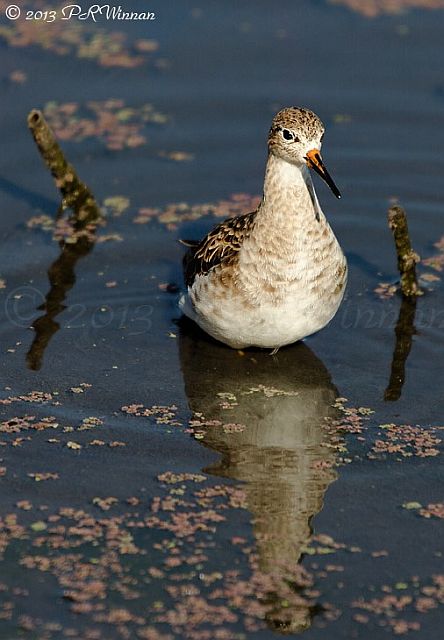 © PRWIN
© PRWIN
Breeding adult, Marievale, Gauteng
Description
29-32 cm. Variable plumaged wader with boldly scaled or scalloped upperparts; male much larger than female. Short straight bill with bulous tip (pink to orange-red in breading season). Small head on long neck. Legs can be green, yellow, orange or flesh-coloured. It shows white oval patches on the sides of the tail in flight. Small proportion of males are whitish on head, upperparts and breast.
Breeding male has extra-ordinary ear tufts, crest and erectile ruff - black, brown, white; barred or streaked. Belly and sides of rump are white. Black breast. Pale narrow wing bar. Bill may be brown, red or yellow.
In flight the white, oval patch on either side of the dark rump is diagnostic.
Ad non-breeding: Upper parts brownish grey and dully scaled. Dark feather centres have pale grey to grey-brown fringes and off-white tips, often with subterminal black dots on scapulars and tertials. Feathers at base of bill frequently white. Lateral upper tail coverts white, centre brownish black, tail dark grey, feathers narrowly bordered white. Upper wing coverts grey. Face to breast pale grey, feathers broadly fringed white; remainder of underparts white. Eyes dark brown. Legs and feet shades of yellow, pink, orange, vermilion or brown, sometimes with green or brown spots or patches.
Similar species: Birds with bright orange/red legs could be mistaken for Common Redshank but lack streaked underparts, and in flight the white secondaries.
Distribution
Breeds in broad strip of land from The Netherlands across Northern Europe to Siberia, heading south in the non-breeding season to India, southern Arabia and much of sub-Saharan Africa, including southern Africa. Here it is common in patches across the region, largely excluding Mozambique.
Habitat
Damp meadows with shallow pools and ditches. It also occurs at salt-marshes, muddy estuaries, temporary pans, dams, vleis, sewage works, salt works and saline wetlands, occasionally moving to cultivated land and the open coast.
Movements and migrations
Its breeding population in Siberia go on the longest migration of any terrestrial bird, as they first leave their colonies in July before heading west to the Black and Caspian Seas, then heading south to southern Africa, a total journey of approximately 16 000 km. It arrives in southern Africa in August, after which adult males leave first in January, followed by immature males in February and finally adult and immature females in April and May. A very small proportion of them stay over winter in the region, usually because of injury.
Diet
It mainly eats invertebrates, such as aquatic insects and crustaceans, doing most of its foraging by wading through shallow water or mud, regularly probing in search of prey or grabbing small insects from the surface.
Breeding
Breeds in wet meadows and marshes. Nests are solitary or semi-colonial. Female builds nest, which is a shallow scrape on ground concealed in vegetation. 3-4 eggs are laid. Female incubates eggs and cares for young.
Call
Mostly silent in winter quarters. Listen to Bird Call.
Status
Summer visitor. Common non-breading Palearctic migrant, main arrivals August/September, departure Januarey/February. Gregarious, usually in small flocks.
Order: Charadriiformes. Family: Scolopacidae
 © PRWIN
© PRWINBreeding adult, Marievale, Gauteng
Description
29-32 cm. Variable plumaged wader with boldly scaled or scalloped upperparts; male much larger than female. Short straight bill with bulous tip (pink to orange-red in breading season). Small head on long neck. Legs can be green, yellow, orange or flesh-coloured. It shows white oval patches on the sides of the tail in flight. Small proportion of males are whitish on head, upperparts and breast.
Breeding male has extra-ordinary ear tufts, crest and erectile ruff - black, brown, white; barred or streaked. Belly and sides of rump are white. Black breast. Pale narrow wing bar. Bill may be brown, red or yellow.
In flight the white, oval patch on either side of the dark rump is diagnostic.
Ad non-breeding: Upper parts brownish grey and dully scaled. Dark feather centres have pale grey to grey-brown fringes and off-white tips, often with subterminal black dots on scapulars and tertials. Feathers at base of bill frequently white. Lateral upper tail coverts white, centre brownish black, tail dark grey, feathers narrowly bordered white. Upper wing coverts grey. Face to breast pale grey, feathers broadly fringed white; remainder of underparts white. Eyes dark brown. Legs and feet shades of yellow, pink, orange, vermilion or brown, sometimes with green or brown spots or patches.
Similar species: Birds with bright orange/red legs could be mistaken for Common Redshank but lack streaked underparts, and in flight the white secondaries.
Distribution
Breeds in broad strip of land from The Netherlands across Northern Europe to Siberia, heading south in the non-breeding season to India, southern Arabia and much of sub-Saharan Africa, including southern Africa. Here it is common in patches across the region, largely excluding Mozambique.
Habitat
Damp meadows with shallow pools and ditches. It also occurs at salt-marshes, muddy estuaries, temporary pans, dams, vleis, sewage works, salt works and saline wetlands, occasionally moving to cultivated land and the open coast.
Movements and migrations
Its breeding population in Siberia go on the longest migration of any terrestrial bird, as they first leave their colonies in July before heading west to the Black and Caspian Seas, then heading south to southern Africa, a total journey of approximately 16 000 km. It arrives in southern Africa in August, after which adult males leave first in January, followed by immature males in February and finally adult and immature females in April and May. A very small proportion of them stay over winter in the region, usually because of injury.
Diet
It mainly eats invertebrates, such as aquatic insects and crustaceans, doing most of its foraging by wading through shallow water or mud, regularly probing in search of prey or grabbing small insects from the surface.
Breeding
Breeds in wet meadows and marshes. Nests are solitary or semi-colonial. Female builds nest, which is a shallow scrape on ground concealed in vegetation. 3-4 eggs are laid. Female incubates eggs and cares for young.
Call
Mostly silent in winter quarters. Listen to Bird Call.
Status
Summer visitor. Common non-breading Palearctic migrant, main arrivals August/September, departure Januarey/February. Gregarious, usually in small flocks.
Last edited by Dewi on Fri Feb 22, 2013 8:29 pm, edited 1 time in total.
Ruff Photos
284. Ruff Calidris pugnax

Macaneta Wetlands, about 30 kms north of Maputo © Dindingwe
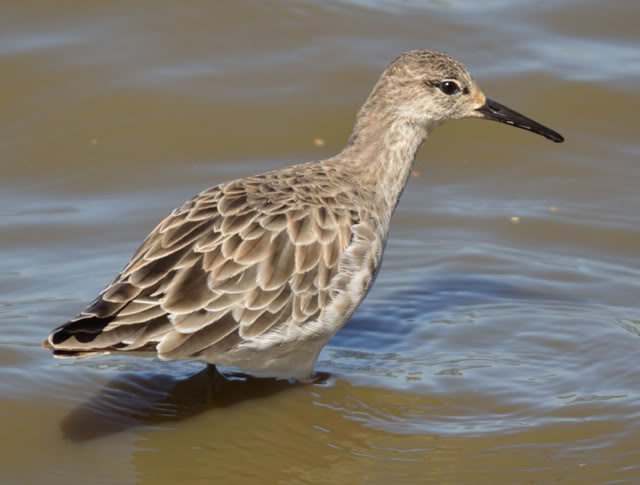 © BluTuna
© BluTuna
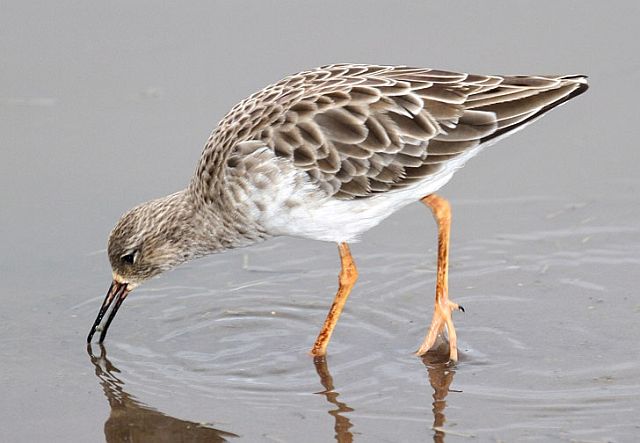 © leachy
© leachy
Sunset dam, Kruger National Park
 © steamtrainfan
© steamtrainfan
Breeding adult
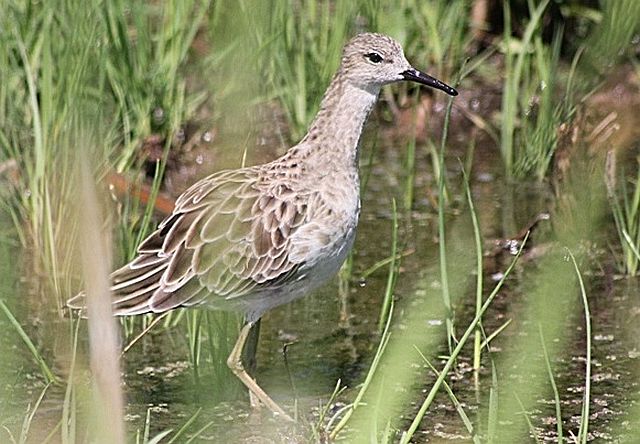 © Amoli
© Amoli
Male, Marievale, Gauteng
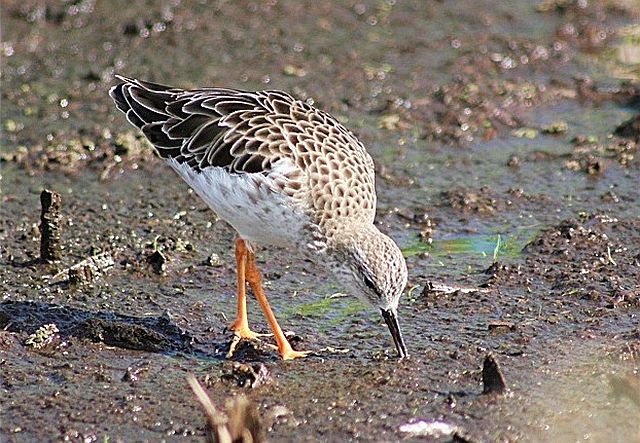 © Amoli
© Amoli
Female, Marievale, Gauteng
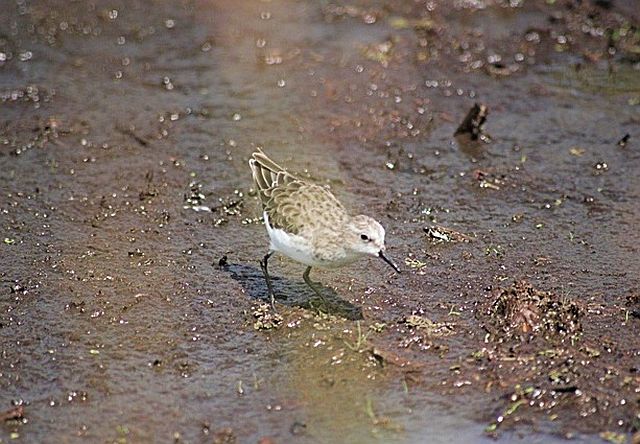 © Amoli
© Amoli
Juvenile, Marievale, Gauteng
Links:
http://sabap2.adu.org.za/docs/sabap1/284.pdf
http://sabap2.adu.org.za/spp_summary.ph ... §ion=3
Hockey, P.A.R. 1998. Africa’s waders: a guide to their identification. Part 2. Africa - Birds & Birding 3(2):63-69.
Macaneta Wetlands, about 30 kms north of Maputo © Dindingwe
 © BluTuna
© BluTuna © leachy
© leachySunset dam, Kruger National Park
 © steamtrainfan
© steamtrainfanBreeding adult
 © Amoli
© AmoliMale, Marievale, Gauteng
 © Amoli
© AmoliFemale, Marievale, Gauteng
 © Amoli
© AmoliJuvenile, Marievale, Gauteng
Links:
http://sabap2.adu.org.za/docs/sabap1/284.pdf
http://sabap2.adu.org.za/spp_summary.ph ... §ion=3
Hockey, P.A.R. 1998. Africa’s waders: a guide to their identification. Part 2. Africa - Birds & Birding 3(2):63-69.
Red Phalarope
291. Red Phalarope Phalaropus fulicaria (Grysfraiingpoot)
Order: Charadriiformes. Family: Scolopacidae

Description
Length 20-22 cm, Wingspan 36-41 cm. Medium-sized sandpiper with dark gray upperparts and rufous neck and underparts.
In breeding plumage, the adults are almost entirely red on their underparts (not just around the neck) and have a black and white head pattern and a mostly yellow bill. Head has white face, black cap, and a thick, straight, yellow bill with black tip. Female is more brightly colored than the male, has darker red and less black on the bill than the male.
Non-breeding: Pale grey upperparts, with white underparts, a dark bill and thick black line through the eye. The lack of stripes on the back and the shorter, thicker bill distinguish them from Red-necked Phalaropes.
Brick red in breeding.
The juveniles have streaks on the mantle like Red-necked Phalaropes but these soon disappear as they moult into first-winter plumage.
Similar species: Red-necked Phalarope's rump is black, fringed with white, while Red Phalarope's rump is grey.
Distribution
High Arctic breeder. Breeds in the circumpolar region mostly above 65° North, heading south in the non-breeding season to the sea, especially in the Humboldt, Benguela and Guinea-Canary upwelling systems. It is a fairly common visitor to southern African waters, occurring off the west coast (especially near southern Namibia) and east up to the area off central Eastern Cape, while it is a vagrant inland.
Habitat
Pelagic. It generally prefers the open ocean, especially where oceanic fronts and upwelling plumes bring food to the surface, rarely moving to coastal salt works or standing water bodies further inland.
Movements and migrations
It first arrives in southern Africa in October, with numbers peaking in December before it departs in March, rarely April.
Diet
Mostly zooplankton, supplemented with a variety of other invertebrates taken opportunistically. It does most of its foraging by pecking and lunging on the surface of the sea or plucking prey from rafts of drifting seaweed.
Breeding
Breeds in coastal wet tundra, sometimes in drier area, but always near fresh or brackish water. Unusually for a bird, it is the female red phalarope that fight for a male, with mate choice ultimately lying with the male. After pairing, the male and female dig a nest scrape and line it with a variety of materials, including grass, stones, feathers and lichen. After three eggs are laid, the female abandons the male to search for another mate, leaving the male to incubate the eggs alone. Occasionally, however, the female may return to lay one more egg. After a 17 to 26 day incubation period, the male continues solo parenthood by caring for the hatchlings.
Call
Contact call wiit. Listen to Bird Call.
Status
Uncommon summer visitor to western coasts.
Order: Charadriiformes. Family: Scolopacidae

Description
Length 20-22 cm, Wingspan 36-41 cm. Medium-sized sandpiper with dark gray upperparts and rufous neck and underparts.
In breeding plumage, the adults are almost entirely red on their underparts (not just around the neck) and have a black and white head pattern and a mostly yellow bill. Head has white face, black cap, and a thick, straight, yellow bill with black tip. Female is more brightly colored than the male, has darker red and less black on the bill than the male.
Non-breeding: Pale grey upperparts, with white underparts, a dark bill and thick black line through the eye. The lack of stripes on the back and the shorter, thicker bill distinguish them from Red-necked Phalaropes.
Brick red in breeding.
The juveniles have streaks on the mantle like Red-necked Phalaropes but these soon disappear as they moult into first-winter plumage.
Similar species: Red-necked Phalarope's rump is black, fringed with white, while Red Phalarope's rump is grey.
Distribution
High Arctic breeder. Breeds in the circumpolar region mostly above 65° North, heading south in the non-breeding season to the sea, especially in the Humboldt, Benguela and Guinea-Canary upwelling systems. It is a fairly common visitor to southern African waters, occurring off the west coast (especially near southern Namibia) and east up to the area off central Eastern Cape, while it is a vagrant inland.
Habitat
Pelagic. It generally prefers the open ocean, especially where oceanic fronts and upwelling plumes bring food to the surface, rarely moving to coastal salt works or standing water bodies further inland.
Movements and migrations
It first arrives in southern Africa in October, with numbers peaking in December before it departs in March, rarely April.
Diet
Mostly zooplankton, supplemented with a variety of other invertebrates taken opportunistically. It does most of its foraging by pecking and lunging on the surface of the sea or plucking prey from rafts of drifting seaweed.
Breeding
Breeds in coastal wet tundra, sometimes in drier area, but always near fresh or brackish water. Unusually for a bird, it is the female red phalarope that fight for a male, with mate choice ultimately lying with the male. After pairing, the male and female dig a nest scrape and line it with a variety of materials, including grass, stones, feathers and lichen. After three eggs are laid, the female abandons the male to search for another mate, leaving the male to incubate the eggs alone. Occasionally, however, the female may return to lay one more egg. After a 17 to 26 day incubation period, the male continues solo parenthood by caring for the hatchlings.
Call
Contact call wiit. Listen to Bird Call.
Status
Uncommon summer visitor to western coasts.
Last edited by Dewi on Fri Feb 22, 2013 8:43 pm, edited 1 time in total.
Dewi
What is the good of having a nice house without a decent planet to put it on? (H D Thoreau)
What is the good of having a nice house without a decent planet to put it on? (H D Thoreau)
Red Phalarope Photos
Dewi
What is the good of having a nice house without a decent planet to put it on? (H D Thoreau)
What is the good of having a nice house without a decent planet to put it on? (H D Thoreau)



